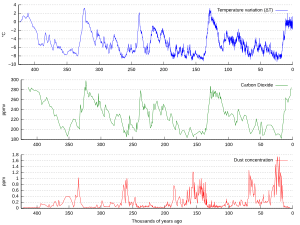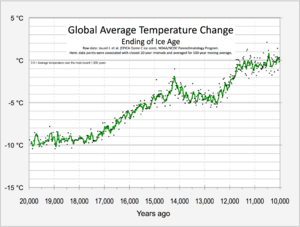Ice age facts for kids

An ice age is a long period when the temperature of Earth's climate is very cold. This causes huge ice sheets to grow across continents. It also makes polar ice and mountain glaciers much larger.
Scientists who study Earth's past climate use the term ice age for times when large ice sheets covered much of the planet. We now know that ice ages have happened many times in Earth's history. The longest and biggest ice age happened a very long time ago, even before complex living things appeared.
During an ice age, the sea level drops. This happens because a lot of water gets trapped in the giant ice sheets at the poles. How much the sea level drops depends on how long the cold period lasts.
Contents
What are Glacials and Interglacials?
Within a long ice age, there are different stages. The longer, very cold stages are called glacials or glacial periods. During these times, ice sheets grow very big. The shorter, warmer periods are called interglacials. We are living in an interglacial period right now!
The last glacial period ended about 11,000 years ago. That's when our current warmer interglacial period began. Even now, large ice sheets still exist in Greenland and Antarctica. The last two million years have been part of the Pleistocene ice age. During glacial times, thick ice sheets covered much of North America and Eurasia. These ice sheets could be several kilometers thick!
How Ice Ages Affect Sea Level
When ice sheets grow during a glacial period, they lock up a lot of water. This water comes from the ocean. Because so much water is frozen into ice, the global sea level drops significantly. For example, during the last major ice age, the sea level was about 120 meters lower than it is today. This exposed land that is now underwater, creating land bridges between continents.
When an interglacial period begins and temperatures rise, the ice sheets melt. This melted water flows back into the oceans, causing the sea level to rise again.
Related Topics
- Snowball Earth: A time when Earth might have been almost completely covered in ice.
- Ice core: Long tubes of ice drilled from glaciers that tell us about past climates.
- Milankovitch cycle: Natural changes in Earth's orbit and tilt that affect how much sunlight reaches the planet.
- Orbital forcing: How these orbital changes influence Earth's climate over long periods.
- Pleistocene: The geological period that includes the most recent ice ages.
- Glaciation: The process of ice forming and moving across land.
Images for kids
-
Scandinavia shows many signs of past ice ages, like deep fjords and lakes.
See also
 In Spanish: Glaciación para niños
In Spanish: Glaciación para niños








